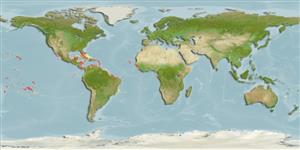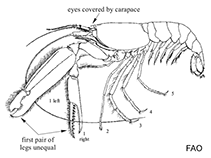Alpheus cristulifrons Rathbun, 1900
Dotted snapping shrimp| Native range | All suitable habitat | Point map | Year 2050 |

|
| This map was computer-generated and has not yet been reviewed. |
| Alpheus cristulifrons AquaMaps Data sources: GBIF OBIS |
Upload your photos
Google image | No image available for this species;
drawing shows typical species in Alpheidae.
Google image | No image available for this species;
drawing shows typical species in Alpheidae.
Classification / Names Common names | Synonyms | CoL | ITIS | WoRMS
Malacostraca | Decapoda | Alpheidae
Environment: milieu / climate zone / depth range / distribution range Ecology
Reef-associated; depth range 0 - 5 m (Ref. 80404). Tropical
Distribution Countries | FAO areas | Ecosystems | Occurrences | Introductions
Eastern Pacific and the Atlantic: USA to Brazil and São Tome and Principe.
Length at first maturity / Size / Weight / Age
Maturity: Lm ? range ? - ? cm Max length : 2.0 cm TL male/unsexed; (Ref. 80376); 1.75 cm TL (female)
Maximum depth from Ref. 97531. Found on rubble (Ref. 97531). Lives in reef edges near tide level and associated with rocks and coral, e.g., Pocillopora and Porites (Ref. 79713), Acropora, Siderastrea and Mussismilia spp. (Ref. 80376). Specifically found in nodules and cavities of calcareous algae, in sponges, in branching dead and living portions of corals in reef edges near tide levels (Ref. 79713). Capable of excavating cavities using its major claw and can excavate tunnels into the coral Mussismilia or into coral's epibiotic growth consisting of coralline algae, ascidians and bryozoans (Ref. 80376). Lives in male/female pairs (Ref. 79713).
Life cycle and mating behavior Maturity | Reproduction | Spawning | Eggs | Fecundity | Larvae
Members of the order Decapoda are mostly gonochoric. Mating behavior: Precopulatory courtship ritual is common (through olfactory and tactile cues); usually indirect sperm transfer.
Main reference
References | Coordinator | Collaborators
Anker, A., C. Hurt and N. Knowlton. 2008. (Ref. 80376)
IUCN Red List Status (Ref. 130435)
CITES status (Ref. 108899)
Not Evaluated
CMS (Ref. 116361)
Not Evaluated
Threat to humans
Human uses
| FishSource |
Tools
More information
Internet sources
BHL | BOLD Systems | CISTI | DiscoverLife | FAO(Publication : search) | Fishipedia | GenBank (genome, nucleotide) | GloBI | Gomexsi | Google Books | Google Scholar | Google | PubMed | Tree of Life | Wikipedia (Go, Search) | Zoological Record
Estimates based on models
Preferred temperature
(Ref. 115969): 25.1 - 28.4, mean 27.5 (based on 826 cells).
Price category
(Ref. 80766):
Unknown.



